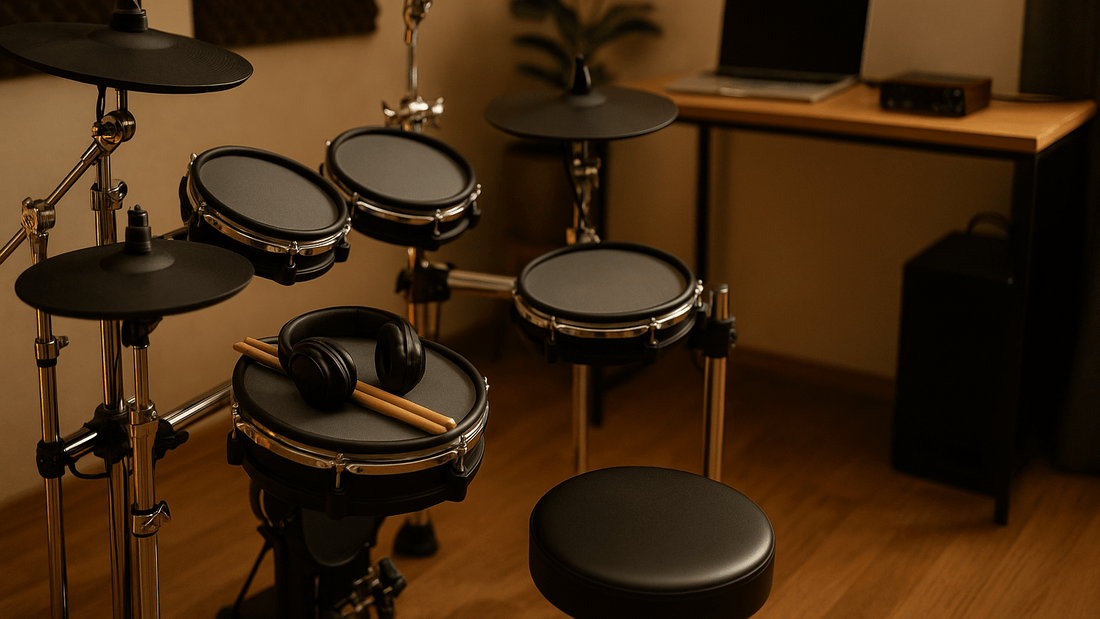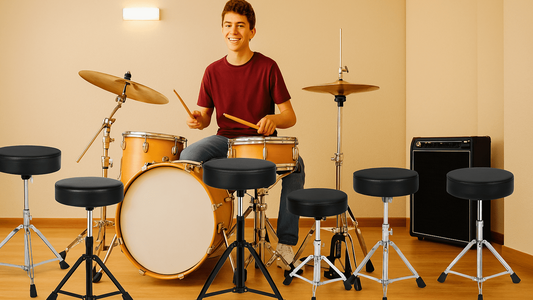1. Why Choose Electric Over Acoustic?
Let’s face it—drums are loud. If you live in an apartment or share a house, banging on an acoustic kit can get you evicted or disowned. That’s where electric drum kits (a.k.a. e-drums) come in. They're game changers, especially in 2025, when the technology has become incredibly lifelike and accessible across all budgets.
Electric drums kits allow you to plug in headphones and jam out in complete silence to the outside world. They’re perfect for late-night practice, urban living, or recording without dealing with mics and soundproofing. You get all the benefits of drumming without the noise complaints.
Plus, e-drums now come with incredible sound engines—many kits offer hundreds of drum sounds, from vintage snares to thunderous metal kits. Some let you load custom samples or connect directly to your DAW (Digital Audio Workstation) via USB or MIDI. Want to sound like Travis Barker or Steve Gadd? It’s a few clicks away.
And don’t forget portability and space. Most electric kits are lightweight and foldable, perfect for small rooms or gigging musicians on the go. Add to that built-in coaching tools, metronomes, and Bluetooth audio playback—and you’ve got an unbeatable practice and performance setup.
In 2025, with kits like the Alesis Nitro Max or Roland TD-17KVX, electric kits are not just an alternative—they're often the better choice.
2. Identify Your Skill Level (Beginner, Intermediate, Pro)
Before you splash the cash, get honest with yourself: where are you on your drumming journey?
Beginner: Just starting out? You need a kit that’s forgiving and affordable, but also helps you build good habits. Look for features like:
-
Mesh heads (they’re easier on your hands and quieter)
-
A coach mode to guide timing
-
Fewer pads but better sensitivity (quality over quantity)
Top 2025 Picks:
-
Alesis Nitro Max – Budget-friendly, full mesh heads, solid sounds.
-
Yamaha DTX402K – Great built-in training tools and a compact footprint.
Intermediate: You’ve been playing a while, maybe jam with friends or dabble in recording. You’ll need more nuanced sounds, dynamic response, and expansion options.
Recommended Kits:
-
Roland TD-17KV – A true drummer’s kit. Realistic feel and USB/MIDI connectivity.
-
Yamaha DTX6K3-X – Excellent sound engine and customizable pad setups.
Professional: For gigging, studio work, or teaching—your kit is an extension of your skill. You need deep editing, multiple triggers, multiple outputs, and a premium feel.
Best in Class:
-
Roland VAD507 – Looks and feels like a real drum set but fully electronic.
-
Yamaha DTX8K-X – Real wood shells and top-tier sound engine.
The key takeaway: Don’t overbuy or underbuy. Match your gear to your current skill set, but leave room to grow.
3. Set Your Budget (Entry-Level, Mid-Range, Professional)
Just like guitars or keyboards, electric drum kits come in tiers. Knowing your budget helps narrow down the thousands of options into a manageable list.
Entry-Level (< $1,000 AUD):
Ideal for beginners and casual players. You won’t get all the bells and whistles, but today’s entry-level kits are surprisingly capable.
What to Expect:
-
Full mesh pads on some models
-
Basic sound module with 30–50 kits
-
Fewer pads (1 crash, 1 ride)
-
Lightweight frame
Top Picks:
-
Alesis Nitro Max (approx. $700 AUD)
-
Yamaha DTX402K (approx. $900 AUD)
Mid-Range ($1,000–3,000 AUD):
The sweet spot for serious hobbyists, home studio musicians, or advancing players.
What You Get:
-
High-quality mesh pads (often dual-zone)
-
Realistic kick pedals
-
Expandable with extra cymbals or toms
-
USB/MIDI for recording
Top Picks:
-
Roland TD-17KVX ($2,600–2,900 AUD)
-
Yamaha DTX6K3-X ($2,800 AUD)
Professional ($3,000+ AUD):
Here, you’re entering studio and performance-ready territory.
Expect Premium Features Like:
-
Multi-zone triggers
-
High-resolution sound samples
-
Separate audio outs for live use
-
Real drum shell aesthetics (in hybrid kits)
Top Choices:
-
Roland VAD507 ($5,000+ AUD)
-
Yamaha DTX8K-X ($4,500–$5,000 AUD)
Before buying, make sure you factor in extras: headphones, drum stool, kick pedal (some kits don’t include it), and possibly a drum amp.
4. Core Features to Look For
A good electric kit isn’t just about price. You need the right features that suit how and where you’ll play. Let’s break down the essentials.
Mesh vs Rubber Pads
This is the most noticeable difference in play feel.
-
Mesh Pads: These feel more like real drums—responsive, quieter, and adjustable tension. In 2025, even entry-level kits like the Alesis Nitro Max include full mesh setups.
-
Rubber Pads: Durable and cheaper, but they feel stiff. They’re also noisier to play, especially if mounted on hard floors.
Unless you’re on a super-tight budget, go mesh.
Single-Zone, Dual-Zone, Multi-Zone Pads
-
Single-Zone: One sound per pad. Fine for beginners.
-
Dual-Zone: Head and rim sounds (e.g., hit the snare center vs rimshot).
-
Multi-Zone Cymbals: Crash with choke, ride bell, bow, and edge.
If you want expressive playing (jazz, metal, funk), multi-zone is a must.
Kick Pedal Setup
Some kits come with:
-
Trigger Pad + Beater Pedal: More realistic feel.
-
Trigger Pedal Only: Quieter and compact, but feels less like a real bass drum.
Choose based on space, noise tolerance, and how much realism you want.
Hi-Hat Options
From simple switch pedals to fully articulated hi-hats on stands, this varies wildly. If you play funk or jazz, a fluid hi-hat action is vital.
Sound Module (Brain)
The sound module is your kit’s control center. Look for:
-
Kit variety (50+ minimum)
-
USB/MIDI out
-
Bluetooth audio input
-
Coach or practice tools
-
Import custom sounds (on higher-end models)
Brands like Roland and Yamaha excel here—solid sound engines that offer decades of experience.
5. Space, Portability & Noise Considerations
Don’t forget: even an electronic drum kit takes up room. You’ll need 1.5m x 1.5m minimum to set up comfortably. If you’re in a small apartment, compact kits like the Roland TD-02KV are ideal.
Noise-wise, electric drums are quieter than acoustics—but not silent. Here’s where noise creeps in:
-
Stick impact on pads (less with mesh)
-
Kick pedal vibrations (especially if you live upstairs)
-
Rack/frame rattles
To reduce this:
-
Place the kit on a thick rug
-
Use isolation pads or tennis balls under the frame
-
Invest in quieter pedals like the Roland KT-10
If you plan to gig, portability is key. A 4-leg folding rack is easier to carry than a hybrid drum shell kit. Always consider your needs before committing.
6. Expandability & Compatibility
One of the greatest perks of electric kits is the ability to expand and customize your setup. You’re not stuck with what comes in the box.
Expandability means you can add:
-
Extra tom pads
-
Additional cymbals (crash, splash, china)
-
Upgraded kick or snare pads
-
External triggers or percussion pads
For instance, the Roland TD-17KVX allows for two extra trigger inputs. This lets you grow your kit over time—ideal for drummers on a budget who plan to upgrade gradually.
Compatibility is equally important. Some brands use proprietary connectors, while others allow standard 1/4" TRS jacks. When shopping, ensure:
-
The sound module supports additional inputs
-
It’s compatible with third-party pads (like ATV or Jobeky)
-
You can use your preferred kick pedal or hi-hat stand
If you’re already deep into a studio setup, make sure the kit integrates well with your DAW (Ableton, Logic, etc.). Most modern kits support USB MIDI and audio over USB—huge for recording directly without an audio interface.
Pro Tip: Stick with well-known brands like Roland or Yamaha if you want long-term compatibility and firmware support. They’re more likely to support future gear.
7. Where to Try & Buy (Online vs In-Store)
Choosing an electric drum kit is a bit like picking out shoes—you’ve got to try them on. Feel matters. So ideally, try before you buy.
Buying In-Store:
Pros:
-
You can physically try out multiple kits.
-
Get hands-on guidance from staff.
-
No shipping worries.
Cons:
-
Limited stock—especially if you’re outside a major city.
-
Prices may be higher than online.
Look for stores like:
-
Mannys Music (Australia-wide)
-
Store DJ
-
Billy Hyde / Allans Music
-
Local drum shops with Roland or Yamaha displays
Buying Online:
Pros:
-
More variety and stock.
-
Often better deals and discounts.
-
Delivered to your door.
Cons:
-
Can’t try before you buy.
-
Risk of shipping damage (always buy from trusted sellers).
Best Online Retailers in Australia:
-
TempoGear
-
Store DJ
-
Amazon AU
-
eBay (with caution—check seller ratings)
Make sure the online store offers a return policy, warranty, and good customer support. A bonus? Many will match in-store pricing if you ask.
8. Top Electric Drum Kit Recommendations by Tier (2025 Picks)
Let’s narrow it down with the best kits for each level in 2025, based on features, price, and performance.
Beginner (Under $1,000 AUD)
| Model | Features | Price (AUD) |
|---|---|---|
| Alesis Nitro Max | Mesh pads, 40 kits, USB MIDI | ~$700 |
| Yamaha DTX402K | Rubber pads, training mode | ~$850 |
| Roland TD-02KV | Compact, great for small spaces | ~$999 |
Intermediate ($1,000–$3,000 AUD)
| Model | Features | Price (AUD) |
|---|---|---|
| Roland TD-17KVX | Dual-zone mesh, Bluetooth audio | ~$2,700 |
| Yamaha DTX6K3-X | TCS pads, dynamic trigger technology | ~$2,800 |
| Alesis Command X | Expandable, SD card sample import | ~$1,400 |
Professional ($3,000+ AUD)
| Model | Features | Price (AUD) |
|---|---|---|
| Roland VAD507 | Full-size shells, high-end sound engine | ~$5,000+ |
| Yamaha DTX8K-X | Real wood shells, USB audio/MIDI | ~$4,800 |
| ATV EXS-5SK | Ultra-sensitive pads, sleek rack design | ~$5,200 |
Each of these kits delivers serious performance for its tier. Don’t forget accessories—quality headphones, a throne, and good sticks make a huge difference.
9. Maintenance Tips for Longevity
Electric drum kits might not need tuning like acoustics, but they still require care.
Cleaning
-
Wipe down mesh pads with a dry cloth after use.
-
Avoid harsh cleaners—use a damp cloth and mild soap if needed.
-
Keep the module screen dust-free.
Pad Wear
-
Mesh heads last years, but overplaying can stretch them. Rotate your playing zones (don’t always hit dead-center).
-
If you notice loss of sensitivity, check cable connections or consider recalibrating.
Cables & Connections
-
Use cable ties to prevent trip hazards and wear.
-
Don’t yank cables from the module—grip the connector, not the cord.
Software Updates
-
Brands like Roland and Yamaha release firmware updates. These can fix bugs or even add new features.
Storage
-
Keep your kit away from moisture and direct sunlight.
-
If you’re not using it for weeks, cover it with a cloth or plastic sheet.
Taking care of your kit ensures it performs reliably and resells at a higher value if you upgrade later.
10. Recording & Connectivity (For Creators & Producers)
In 2025, your e-kit isn’t just a practice tool—it’s a music production powerhouse.
Home Recording Made Easy
Most mid- to high-end kits support:
-
USB Audio: Plug directly into your computer and record multi-track drum audio.
-
USB MIDI: Control VST drum plugins like Superior Drummer, EZdrummer, or Addictive Drums.
-
SD Card Sample Import: Load your own sounds for live or studio use (available on kits like Alesis Command X or Roland TD-27).
Live Use
Some drummers gig with electric kits or hybrid setups (electronic + acoustic). Choose kits with:
-
Multiple audio outputs
-
Click track routing
-
Sturdy frames and realistic pads
DAW Compatibility
Most major kits are plug-and-play with:
-
Ableton Live
-
Logic Pro
-
FL Studio
-
Reaper
You can also sync your kit with backing tracks, use loopers, or trigger samples in real-time. The possibilities are endless.
Pro Tip: If you’re recording with a band, make sure to set proper latency and buffer settings in your DAW. Too much lag will throw off your timing.
11. Coaching Tools & Practice Modes
One of the most underrated benefits of modern e-kits? Built-in coaching tools. These aren’t just gimmicks—they can seriously level up your drumming skills, especially if you’re self-taught or don’t have a tutor nearby.
Common Practice Features:
-
Time Check: Measures how accurately you hit on the beat.
-
Quiet Count: Mutes the metronome so you rely on your internal timing.
-
Pattern Training: Play along with rhythms and gradually increase tempo.
-
Warm-Up Routines: Pre-made exercises to build hand speed and control.
For example, the Yamaha DTX402K offers 10 built-in training functions, while the Roland TD-17KVX includes Bluetooth audio so you can practice with Spotify or YouTube tracks directly through the kit.
Smart App Integration
Many kits now come with companion apps:
-
Yamaha Rec'n'Share – Record and share performances instantly.
-
Roland Coach App – Track progress, follow lessons, and set practice goals.
-
Melodics for Drums – A gamified training app compatible with MIDI e-kits.
If you're learning alone, these tools can replace an in-person tutor. Some even gamify your practice with scoring and levels, keeping you motivated over the long haul.
12. Common Mistakes to Avoid When Buying
Before you drop hundreds or thousands of dollars, here are a few common pitfalls that first-time buyers make.
1. Ignoring Pad Feel
You might get swayed by a cool sound module or tons of presets. But if the pads feel terrible under your sticks, you won’t enjoy playing. Always prioritize mesh over rubber if budget allows.
2. Overlooking Expansion Ports
You might not want an extra cymbal or tom now, but you probably will in six months. Make sure the module has extra inputs.
3. Skimping on Accessories
Don’t forget the essentials:
-
Drum throne
-
Kick pedal (some kits don’t include one!)
-
Isolation mat or carpet
-
Quality headphones
4. Focusing Only on Brand
Yes, Roland and Yamaha are top-tier. But don’t ignore brands like Alesis or ATV—many offer better value, especially for beginners or intermediate players.
5. Not Considering Future Use
Will you be gigging? Recording? Teaching? Choose a kit that aligns with your real-world needs, not just what's cool in the moment.
13. Benefits of Electric Drumming Beyond Practice
Electric kits aren’t just about silent practice. They open doors to a whole new world of creative possibilities.
Recording
Plug in and start tracking—no mics, no room treatment, no fuss. Multi-track USB recording lets you isolate kick, snare, toms, etc., for clean mixes.
Live Performance
With today’s sound modules and amp options, you can gig with an electric kit and get consistently great sound, no matter the venue.
Hybrid Kits
Many pro drummers combine acoustic shells with e-pads and triggers. This hybrid approach gives you the best of both worlds: natural feel with enhanced control.
Composing & Arranging
You can use your e-kit to lay down drum tracks in DAWs, build beats, and explore genres—from metal to EDM. Want an 808 bass kick and jazz ride? You got it.
14. Final Tips for Making the Right Choice
To wrap up your buying journey, here’s a checklist before you hit “buy now”:
-
✅ Does it have mesh pads?
-
✅ Is the sound module USB/MIDI compatible?
-
✅ Are there extra trigger inputs for future expansion?
-
✅ Are you getting all essential parts (kick pedal, throne, headphones)?
-
✅ Does it match your current and future needs?
-
✅ What’s the warranty and return policy?
If possible, try a few kits in person. Trust your hands and ears. And remember—it’s better to buy the right kit once than buy the wrong one twice.
15. Conclusion
Choosing the right electric drum kit can feel overwhelming at first. But now that you know what to look for—from mesh pads to MIDI, beginner setups to pro-level rigs—you’re in the perfect spot to make an informed choice.
Whether you're practicing silently at midnight, recording in a home studio, or gigging with a hybrid setup, an electric drum kit offers incredible value and flexibility. In 2025, there’s truly a kit for every level and every budget.
Don't rush the process. Take your time, test things out, and make sure it feels right under your sticks. And once you’ve got your kit, just play. The more you play, the more you’ll love it.
FAQs
Q1: Are mesh heads really better than rubber pads?
Yes, mesh heads are quieter, feel closer to acoustic drums, and are generally easier on the wrists. They're standard in most mid-range and premium kits today.
Q2: Can I use my electric drum kit for live performances?
Absolutely. Many professionals gig with electric kits or hybrid setups. Just make sure you have a good sound module and amplification setup.
Q3: What headphones are best for electronic drums?
Look for over-ear, closed-back studio headphones like the Audio-Technica ATH-M50x or Roland RH-300. They isolate sound and deliver clear detail.
Q4: How do I record my e-kit into a computer?
Most kits offer USB audio and MIDI. Connect the USB to your computer, select the kit as your input in your DAW (e.g., Ableton, Logic), and hit record.
Q5: Is it worth getting a second-hand electric drum kit?
It can be—if you inspect it carefully. Check pad sensitivity, cable condition, and sound module functionality. Stick with well-known brands for resale value and support.




